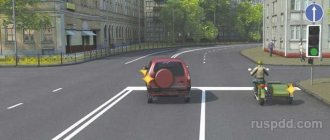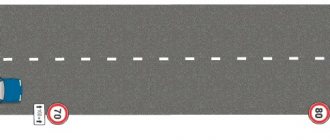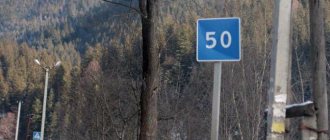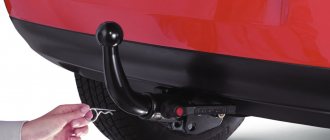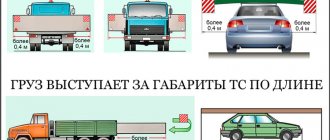What is written about driving in the left lane in the traffic rules?
Answers to all questions about driving in the left lane are contained in clauses 9.4 and 9.5 of the traffic rules. For the most part, the bans apply to suburban routes:
- Outside populated areas, you cannot drive in the left lane, except when turning left or ahead. The same applies to other roads on which driving at speeds over 80 km/h is permitted if they are marked with signs 5.1 (motorway) or 5.3 (road for cars, motorcycles and buses).
- In populated areas you can drive in any lane, with some exceptions. For example, if the maximum speed of a vehicle does not exceed 40 km/h, the driver can only move on the far right. The exception is turns, U-turns, and avoidance of obstacles: in this case, driving to the left is allowed.
- If there are three or more lanes on the road. Here, location does not matter: you can occupy the far left lane only if the other two are occupied by other cars and there is heavy traffic. You are also allowed to exit only to turn left or make a U-turn.
Vehicles with a permissible maximum weight of 2.5 tons may enter the leftmost lane of three or more lanes only to make a U-turn or turn left.
Let's look at a few examples of how this should look in practice:
No. 1. Driving through a populated area. The driver is driving on a two-lane road, taking the extreme left position. There is no violation here: clause 9.4 of the traffic rules contains no prohibitions. Then the number of lanes changes, and there are already three in the same direction. Here the driver can take the far left lane only if the remaining lanes are occupied during active traffic, or he needs to turn left or turn around.
It is worth considering signs and markings. Even if when driving in a city there are two lanes, but there are signs indicating the direction of travel, you need to be guided by them. For example, you cannot drive straight in the left lane if the sign indicates that on this section of the road you can only turn around or turn left.
No. 2. Driving outside the populated area. The end of a populated area is indicated by sign 5.24.1, but restrictions can also be lifted by sign 3.31. A man is driving a car in the right lane. The car ahead is moving at a lower speed, so the other driver is allowed to get ahead of it. After completing the maneuver, he must return to his lane.
Many drivers have an unspoken rule that will help avoid some unpleasant situations. Despite the fact that driving in the city in the left lane is in most cases allowed according to traffic regulations, experienced car owners consider driving there with a free right lane considered bad manners.
Another issue is when both lanes are occupied and the car on the left is driving just as slowly as the one on the right. In fact, it turns out that the entire road is occupied, and those who are driving faster than them from behind will not be able to pass, or they will have to drive into oncoming traffic in violation of traffic rules. According to the rules, both drivers in front are right, but in order to avoid traffic conflicts, it is better not to do this.
Driving in the left lane in a populated area
The speed of movement within populated areas is limited to 60 km/h (clause 10.2 of the traffic rules). In addition, the intersections of roads in a populated area form many intersections of different types.
Since the leftmost lanes are intended for driving “straight” and for turning left or making a U-turn (and sometimes only for turning left or making a U-turn), following the left lane with the intention of going “straight” through it, and if you do not have time to change lanes in advance, there is a risk "get stuck" at an intersection.
In order not to wait for the “front” car to turn or turn around and clear the passage, you can go around it on the right side - essentially changing lanes at the intersection.
This maneuver must be carried out with increased attention (first clarify for yourself the situation on the right and rear of your car), because in the current situation there is a high probability of a collision with a car that is driving in the adjacent lane in the direction “straight” through the intersection.
In heavy traffic conditions, under these conditions, an accident is most likely, because everyone is in a hurry to get through while the traffic light is on. Read more about other tense moments in the article Changing lanes (changing lanes) at an intersection.
Often, entry into the adjacent territory located to the left of the road is organized from the left lanes, for example, a turn to a gas station. Having accelerated in the left lane, there is a possibility of unexpectedly running into a car, which, allowing its oncoming cars to pass, is waiting for the opportunity to turn left or turn around on such a section of the road.
To drive further, you will have to go around it on the right, in the adjacent lane (there is no other permitted route), again, you should do the detour very carefully, first making sure that it will be safe to change lanes into the adjacent lane.
If you do not notice in time (still at the entrance) a car stopped in the leftmost lane for a turn (turn), or notice it too late, then any development of events is possible, incl. a collision with him due to the fact that there is no longer enough distance to stop before him, and there will also be no opportunity to go around him on the right.
One such case is discussed using the example of a real traffic situation in the article Unexpected “surprise” on the second lane.
A slightly different case of an accident, also associated with leaving the occupied left lane, is discussed in the article Changing lanes - that’s how it happens. Both articles contain videos of what is happening.
On the left lanes anywhere on the road, not just at intersections, anything can happen, incl. any “obstacle” arises in the form of an accident, a car that stops due to a breakdown or because the driver suddenly feels ill, etc.
Therefore, it is necessary to drive the car in accordance with weather and road conditions, constantly look far away, several cars ahead, analyze the situation and take safety measures in advance (at least reduce speed in advance).
When is it legal to drive in the left lane?
There are several situations when you can drive into the left lane without fear of a fine:
- if there is another car ahead and you need to overtake it;
- if there is an obstacle on the right in the form of an accident, road work, etc.;
- if the driver wants to turn around or turn left;
- if the right side of the road is broken and driving on it is dangerous.
If we are talking about an area outside the city or about driving on a three-lane road in the city, after completing any of the above maneuvers, you need to return to your lane. The left side cannot be occupied, even if it is empty and there are no other vehicles behind that could be interfered with by the car.
Choosing the right lane to drive
The last point I will touch on in the first article of the series is choosing the right lane outside the city. To do this, consider paragraph 9.4 of the traffic rules:
9.4. Outside populated areas, as well as in populated areas on roads marked with signs 5.1 or 5.3 or where driving at a speed of more than 80 km/h is permitted, vehicle drivers must drive them as close as possible to the right edge of the roadway. It is prohibited to occupy the left lanes when the right lanes are free. In populated areas, taking into account the requirements of this paragraph and paragraphs 9.5, 16.1 and 24.2 of the Rules, vehicle drivers can use the lane that is most convenient for them. In heavy traffic, when all lanes are occupied, changing lanes is only allowed to turn left or right, make a U-turn, stop, or avoid an obstacle.
Thus, outside a populated area you need to drive in the far right lane, and only if it is busy can you drive in other lanes. At this point the question arises: “What is a busy lane,” the answer to which is not given in the traffic rules.
It is obvious that the lane can be occupied by cars, but whether it can be occupied by potholes and potholes is not completely clear.
In addition, outside the city there may be roads that objectively have only one lane (track), but the width allows two cars to pass each other. Those. the track is rolled in the middle of a two-lane road. This is especially true in winter on small country roads.
So, in the situation described, I recommend driving either with all wheels in the track, or with all wheels off the track. If you ignore this advice and drive with two wheels on asphalt and two on ice, you can end up in a very unpleasant situation when braking.
What is the fine for driving in the left lane?
If the driver violates clause 9.4 or clause 9.5 of the traffic rules, he may be held accountable under Part 1 of Art. 12.15 of the Code of Administrative Offenses for violating the rules for placing a car on the road. The fine here is 1,500 rubles.
Only a traffic police inspector can record a violation. Cameras recording non-compliance with clause 9.4 or clause 9.5 of the traffic rules have not yet been installed anywhere. A protocol is drawn up on site, which will immediately indicate the details for payment.
If you pay the fine within 20 days, you can take advantage of a discount of 50% of the amount. In the end, only 750 rubles are transferred instead of 1,500 rubles.
Dear reader! Didn't receive an answer to your question? Our expert lawyers work for you. It's absolutely free!
- Moscow ext 152
- St. Petersburg ext 152
- All regions ext 132 (Toll free)
How to navigate the lanes
Even those new to driving are interested in the issue of driving in lanes outside populated areas.
You can find the answer in paragraph 9.4 of the current Traffic Rules.
Everything is simple here. Outside cities and villages, where the speed limit is more than 80 km/h, drivers should move closer to the right side. That is, closer to the side of the road. It is prohibited to occupy the left lane if the right one is free.
There are also roads where there are 3 or more lanes in one direction. Then you can get into the left lane only in case of heavy traffic, as well as when the other lanes are occupied. You can also move there to make a left turn, as well as a U-turn.
Freight vehicles with a permissible weight of more than 2.5 tons are allowed to stand in the left lane only for U-turns, as well as for left turns.
When the road has 4 lanes or more, and traffic occurs outside the city, drivers should stay in the right lane. It is prohibited to occupy and continue driving in the left lanes. The exception is turning, turning, and overtaking (advanced).
If the driver is driving a truck weighing over 3.5 tons, then he is prohibited from moving further than the second lane.
Driving in the left lane solely because it is more convenient or there are fewer cars there will result in a fine. Depending on under what article the inspector will be held accountable. You will have to pay 1000 or 1500 rubles.
Is it possible to drive in the left lane within the city?
As mentioned earlier, clause 9.4 of the traffic rules applies only to suburban sections of roads. In the city, you can drive in any lane, the main thing is to follow the instructions of the signs and markings.
However, initially the left lane is intended for turns, driving left and overtaking. If you drive it straight, there will be no fine for it. An exception is certain types of vehicles that are prohibited from driving on the left unless absolutely necessary:
- heavy trucks;
- towed and towing vehicles;
- vehicles that technically cannot accelerate to a speed of more than 40 km/h;
- faulty cars whose drivers drive with their emergency lights on.
The above categories of vehicles can drive on the road on the left only if their drivers intend to turn left or make a U-turn.
Driving in lanes outside the populated area
The next question is which lanes are allowed to drive outside the populated area. This is answered by paragraph 9.4 of the traffic rules:
“Outside populated areas, as well as in populated areas on roads marked with signs 5.1 or 5.3 or where driving at a speed of more than 80 km/h is permitted, vehicle drivers must drive them as close as possible to the right edge of the roadway. It is prohibited to occupy the left lanes when the right lanes are free. ...
... However, on any roads that have three or more lanes for traffic in a given direction, it is allowed to occupy the extreme left lane only in heavy traffic, when other lanes are occupied, as well as for turning left or making a U-turn, and for trucks with a permissible maximum weight of more than 2, 5t – only for turning left or making a U-turn. Entering the left lane of one-way roads to stop and park is carried out in accordance with paragraph 12.1 of the Rules.
Thus, if a road has four or more lanes, then when driving outside a populated area, you should keep to the right lanes. Occupying the left lanes is permitted in accordance with paragraph 9.4 (when the right lanes are occupied, for turning left and making U-turns). In addition, on highways it is prohibited to drive trucks with a permissible maximum weight of more than 3.5 tons beyond the second lane (clause 16.1 paragraph 3).
Driving in the left lane without the reasons specified in clause 9.4, only because it is more convenient, entails sanctions under Article 12.15, Part 1 (fine 1,500 rubles), and for violating Clause 16.1, Paragraph 3 of the Traffic Regulations - under Article 12.11 Part 2 (fine 1000 rubles).
What should you do if you were driving in the left lane and stopped by a traffic police officer?
Despite the provided liability, it is extremely problematic to be held accountable for driving in the left lane on a section of the road where it is prohibited unless necessary. Inspectors will have to prove that the driver violated traffic rules. He, in turn, can explain driving on the left as follows:
- the right lane was occupied by another car traveling at a lower speed, and it was necessary to get ahead of it;
- There was an obstacle in the right lane that we had to go around: a hole, a pothole, an accident.
Most often, drivers explain driving in the left lane by looking for a left turn. Inspectors have no right to punish for this. If the protocol is nevertheless drawn up, you need to make a note of disagreement on it and indicate the reasons. After this, the protocol can be challenged through the court or the head of the traffic police.
Where should you not drive in the left lane?
In addition to the obvious cases when the left side of the road is intended for oncoming traffic and is separated from the right by a solid line, or other rules prohibit driving on it, there are many more road situations when driving in the left lane is prohibited.
Outside populated areas
On highways, that is, outside the coverage area of settlement signs on a white background, it is prohibited to drive in the left lane (if there are 2 or more lanes for driving in one direction), except for a number of exceptions:
- outside a populated area, you can drive in the left lane if the right lanes are occupied - and it doesn’t matter whether you are ahead of the cars on the right or moving at the same speed,
- in addition, you can move in the same place if you are going to turn left or turn around.
All of the above is prescribed by clause 9.4 of the traffic rules.
In this diagram, only the driver of the red car violates
Please note that you are not required in this context to yield to the left lane if another car is approaching you from behind. Including if she presses herself, blinks distantly and asks in every possible way to move to the right.
But in the context of turning left or making a U-turn, traffic rules require you to take the extreme left position in advance. At the same time, there is no specificity of such lead time in the Rules - be it a few tens of meters before the maneuver or 10 kilometers. And yet, all these issues should be looked at from the practical side - in the form of a fine or in the event of an accident. And in this case, the decision on timeliness will be made by an official (traffic police officer) or a judge, based on personal convictions.
In the city when driving 80 km/h
The same rule above applies to a populated area in 3 cases:
- if the relevant speed limit sign allows you to drive more than 80 km/h (note that “more” means not inclusive),
- if the road is marked with a 5.1 Motorway sign, like this:
- or sign 5.3, like this:
In a populated area with 3 or more lanes
Another situation when you cannot occupy the far left lane within a city, village or any other settlement is the presence of 3 lanes for traffic in your direction.
But even in this case, 2 conditions must be met for the ban on driving in the left lane to apply:
- there must be heavy traffic when other lanes are occupied,
- you don't need to turn left or turn around any time soon.
In this picture, drivers of red and green cars are already violating, since the right lanes are free (green could get ahead of orange on the far right)
Please note that trucks with a maximum weight of more than 2.5 tons are allowed to occupy the far left lane in the city in this case only for turning/turning, but in heavy traffic you cannot go to the far left.


